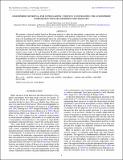Atmospheric Retrieval for Super-Earths: Uniquely Constraining the Atmospheric Composition with Transmission Spectroscopy
Author(s)
Benneke, Bjoern; Seager, Sara
DownloadSeager_Atmospheric retrieval.pdf (8.699Mb)
PUBLISHER_POLICY
Publisher Policy
Article is made available in accordance with the publisher's policy and may be subject to US copyright law. Please refer to the publisher's site for terms of use.
Terms of use
Metadata
Show full item recordAbstract
We present a retrieval method based on Bayesian analysis to infer the atmospheric compositions and surface or cloud-top pressures from transmission spectra of exoplanets with general compositions. In this study, we identify what can unambiguously be determined about the atmospheres of exoplanets from their transmission spectra by applying the retrieval method to synthetic observations of the super-Earth GJ 1214b. Our approach to inferring constraints on atmospheric parameters is to compute their joint and marginal posterior probability distributions using the Markov Chain Monte Carlo technique in a parallel tempering scheme. A new atmospheric parameterization is introduced that is applicable to general atmospheres in which the main constituent is not known a priori and clouds may be present. Our main finding is that a unique constraint of the mixing ratios of the absorbers and two spectrally inactive gases (such as N[subscript 2] and primordial H[subscript 2]+ He) is possible if the observations are sufficient to quantify both (1) the broadband transit depths in at least one absorption feature for each absorber and (2) the slope and strength of the molecular Rayleigh scattering signature. A second finding is that the surface pressure or cloud-top pressure can be quantified if a surface or cloud deck is present at low optical depth. A third finding is that the mean molecular mass can be constrained by measuring either the Rayleigh scattering slope or the shapes of the absorption features, thus enabling one to distinguish between cloudy hydrogen-rich atmospheres and high mean molecular mass atmospheres. We conclude, however, that without the signature of molecular Rayleigh scattering—even with robustly detected infrared absorption features (>10σ)—there is no reliable way to tell from the transmission spectrum whether the absorber is a main constituent of the atmosphere or just a minor species with a mixing ratio of X [subscript abs] < 0.1%. The retrieval method leads us to a conceptual picture of which details in transmission spectra are essential for unique characterizations of well-mixed exoplanet atmospheres.
Date issued
2012-06Department
Massachusetts Institute of Technology. Department of Aeronautics and Astronautics; Massachusetts Institute of Technology. Department of Earth, Atmospheric, and Planetary SciencesJournal
Astrophysical Journal
Publisher
IOP Publishing
Citation
Benneke, Bjoern, and Sara Seager. “Atmospheric Retrieval for Super-Earths: Uniquely Constraining the Atmospheric Composition with Transmission Spectroscopy.” The Astrophysical Journal 753.2 (2012): 100. © 2012 IOP Publishing
Version: Final published version
ISSN
0004-637X
1538-4357